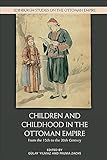Children and Childhood in the Ottoman Empire : From the 15th to the 20th Century / ed. by Gülay Yilmaz, Fruma Zachs.
Material type: TextSeries: Edinburgh Studies on the Ottoman Empire : ESOEPublisher: Edinburgh : Edinburgh University Press, [2022]Copyright date: ©2021Description: 1 online resource (424 p.) : 9 B/W illustrations; 8 B/W tables; 8 graphsContent type:
TextSeries: Edinburgh Studies on the Ottoman Empire : ESOEPublisher: Edinburgh : Edinburgh University Press, [2022]Copyright date: ©2021Description: 1 online resource (424 p.) : 9 B/W illustrations; 8 B/W tables; 8 graphsContent type: - 9781474455411
- 305.230956 23
- online - DeGruyter
| Item type | Current library | Call number | URL | Status | Notes | Barcode | |
|---|---|---|---|---|---|---|---|
 eBook
eBook
|
Biblioteca "Angelicum" Pont. Univ. S.Tommaso d'Aquino Nuvola online | online - DeGruyter (Browse shelf(Opens below)) | Online access | Not for loan (Accesso limitato) | Accesso per gli utenti autorizzati / Access for authorized users | (dgr)9781474455411 |
Frontmatter -- Contents -- Illustrations -- Acknowledgements -- Notes on Transliteration and Pronunciation -- Foreword -- Introduction -- 1. Ottoman Childhoods in Comparative Perspective -- PART I CONCEPTS OF CHILDHOOD -- 2. Childhood in the Peasant Militia Registers and the Age Boundaries of Adolescence -- 3. An Ottoman Boyhood: Child Life in the Late Eighteenth Century through the Lens of Panayis Skouzes’ Autobiography -- PART II FAMILY INTERRELATIONSHIPS -- 4. Preliminary Observations on the Demographic Roots of Modern Childhood in the Ottoman Empire: Wealth, Children and Status in Ruse, Vidin and Sofia, 1670–1855 -- 5. The Emotional Bond between Early Modern Ottoman Children and Parents: A Case Study of Sünbülzade Vehbi’s ‘Ideal’ Child (1700–1800) -- 6. A World of Conflicts: Youth and Violence towards Parents in the Family in Rural Wallachia, 1716–1859 -- PART III CHILDREN OUTSIDE FAMILY CIRCLES -- 7. Born and Bred in Seventeenth-century Crimea: Child Slavery, Social Reality and Cultural Identity -- 8. Rural Girls as Domestic Servants in Late Ottoman Istanbul -- 9. Muslim Orphans and the Shari‘ah in Nineteenth-century Palestine: Cases from Nablus -- PART IV CHILDREN’S BODIES -- 10. Body Politics and the Devsirmes in the Early Modern Ottoman Empire: The Conscripted Children of Herzegovina -- 11. Pastimes for the Child Breadwinners: The Sanitisation and Recreation Facilities of the Hereke Factory Campus -- 12. Beating is Heaven-sent: Corporal Punishment of Children in the Late Ottoman and Early Republican Era -- PART V CHILDREN AND EDUCATION -- 13. Childhood and Education in Ottoman Bosnia during the Early Modern Period (Mid-fifteenth to Late Eighteenth Century) -- 14. Children’s Education in Ottoman Jewish Society (Sixteenth to Eighteenth Centuries) -- 15. Women as Educators towards the End of the Nahda Period: Labiba Hashim and Children’s Upbringing -- Glossary -- Notes on Contributors -- Index
restricted access online access with authorization star
http://purl.org/coar/access_right/c_16ec
Explores 5 centuries of changing attitudes toward children and childhood in the Ottoman EmpireIncludes data on Christian, Jewish and Muslim children that shed light on differences and commonalities in family structures and communitiesCovers a broad geographic area including Ottoman Romania, Bulgaria, Crimea, Greece, Bosnia, Syria, Palestine and IstanbulPaves the way for new directions in research on the history of children and childhood in the Ottoman EmpireFeatures a Foreword by Suraiya Faroqhi, an introductory chapter by Colin Heywood, and includes 8 tables, 8 graphs, 9 illustrations and a glossary of key termsHow did adults, religious institutions and the state view children during the Ottoman Empire? This volume gathers specialists in the social history of the Ottoman Empire as a whole – in regions ranging from Anatolia through the Arab provinces to the Balkans, and from the 15th to the early 20th century – to respond to recent theoretical calls to recognise children as active agents in history. Divided into 5 thematic sections – concepts of childhood, family interrelationships, children outside family circles, children’s bodies and education – the volume covers the social and political structure of the Ottoman Empire. It uses the innovative prism of children as social agents who are not only shaped by but also shape society, rather than being the passive recipients of their social environment.
Mode of access: Internet via World Wide Web.
In English.
Description based on online resource; title from PDF title page (publisher's Web site, viewed 01. Dez 2022)


